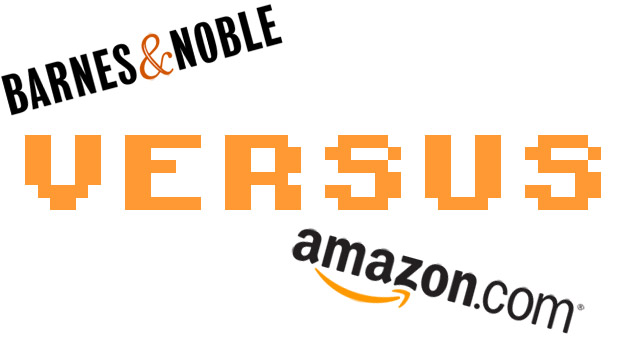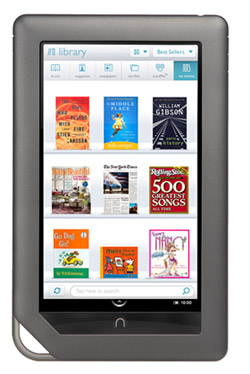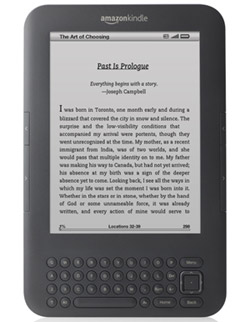
Barnes & Noble just announced the Nook Color a few moments ago, and my initial reaction was much the same as Devin’s: yikes! I guess a color LCD screen is perfect for reading Goldilocks and The Three Bears, but when it comes to reading grown-up books, books with words in them, meh. With that in mind, let’s see how the Nook Color stacks up against the Amazon Kindle, it’s biggest competitor.
Screen

The Nook Color uses what Barnes & Noble calls a VividView Color Touchscreen. It’s seven inches along the diagonal. It would appear to be a plain ol’ color LCD touchscreen. Meanwhile, the Kindle uses the latest generation E-Ink display, coming in at six inches along the diagonal. Now, I can’t speak to this new Nook screen, but I have been known to defend E-Ink displays here and there. They work. You can use them in the sunshine (i.e., on the beach or in the park or on your deck) perfectly, and they put zero strain on your eyes. I guess if color matters to you—perhaps you’re reading Nickelodeon magazine?—then the Nook Color might be worth a punt, but it’s definitely something I’d have to use for a bit before making any judgement calls.
Available Content
After the screen (or maybe even before), the next thing you think about when buying an e-readers is, what kind of things can I read on it? Both Amazon and Barnes & Noble have a pretty deep selection of books to choose from (although Barnes & Noble doesn’t have Patrick Barclay’s new biography of Sir Alex Ferguson, which I’m currently reading). Amazon claims to have a library of more than 725,000 e-books, while Barnes & Noble claims “more than two million titles.” That’s probably counting the Google-scanned books that can be found for free on the store. In any event, I would guess that both stores are comparable. If you have a book in mind best to check to see which store, if any, has it in electronic form.
It should be noted that with the move to color, Barnes & Noble is really hammering home its ability to read things like magazines and children’s books, which is probably a fair point: I can’t really see the appeal children’s books, which are necessarily colorful, on a black-and-white E-Ink screen. Certain magazines, too, might benefit from the color screen, but that wholly depends on the types of magazines you read. You don’t really read the New Yorker for its color photographs and illustrations, do you? Then again, the artwork is what makes something like Edge such a joy to read.
Miscellaneous Features

Both use Wi-Fi to download books, and certain models let you download over 3G, which is of limited utility—how often do you get the urge to download a new book when you’re not within range of Wi-Fi? Both come with a great deal of storage space (8GB for the Nook Color, 4GB for the Kindle, 3GB of which can be used for user storage).
For the Nook Color, Barnes & Noble is really pushing its “social” features. Tell your friends that you’re reading Whatever using Twitter and Facebook. Useful, I suppose, if you’re active on online social networks. You can also lend certain books to your friends. I say “certain” because not all books can be lent.
Battery life seems OK for the Nook Color, rated at eight hours (with the Wi-Fi turned off). The Kindle blows this out of the water, with battery life (with the Wi-Fi turned off) rated at one month That’s not even a difference of night and day, but a difference of, well, night and 30 days~!
Last Thoughts
Let’s be frank: the biggest, and most important, difference between the Kindle and the Nook Color is the screen. Well, and price: the most expensive Kindle (the one that can download books over 3G) costs $189 to the Nook Color’s $249. Not a huge difference, but a difference nonetheless.
I pretty much laid all of this out a few months (weeks? I’ve lost all track of time) ago. A black-and-white display is fine when you’re reading text-heavy books. You know, histories, biographies, novels, etc. Maybe if you have children and you want an e-reading device a color screen would be worth something to you. You can read Dracula just fine in paperback form, or in black-and-white e-book form. The same probably can’t be said about all those Dr. Seuss books: color is huge there.
But I’m not a child, nor do I have any, so I’m probably not going to need a color screen like, say, John might.
That’s about all I can say without having used the Nook Color. I can’t answer questions like “How does it look in the sunlight?”
The Nook Color is scheduled for release on November 19. The Kindle is available now, of course.